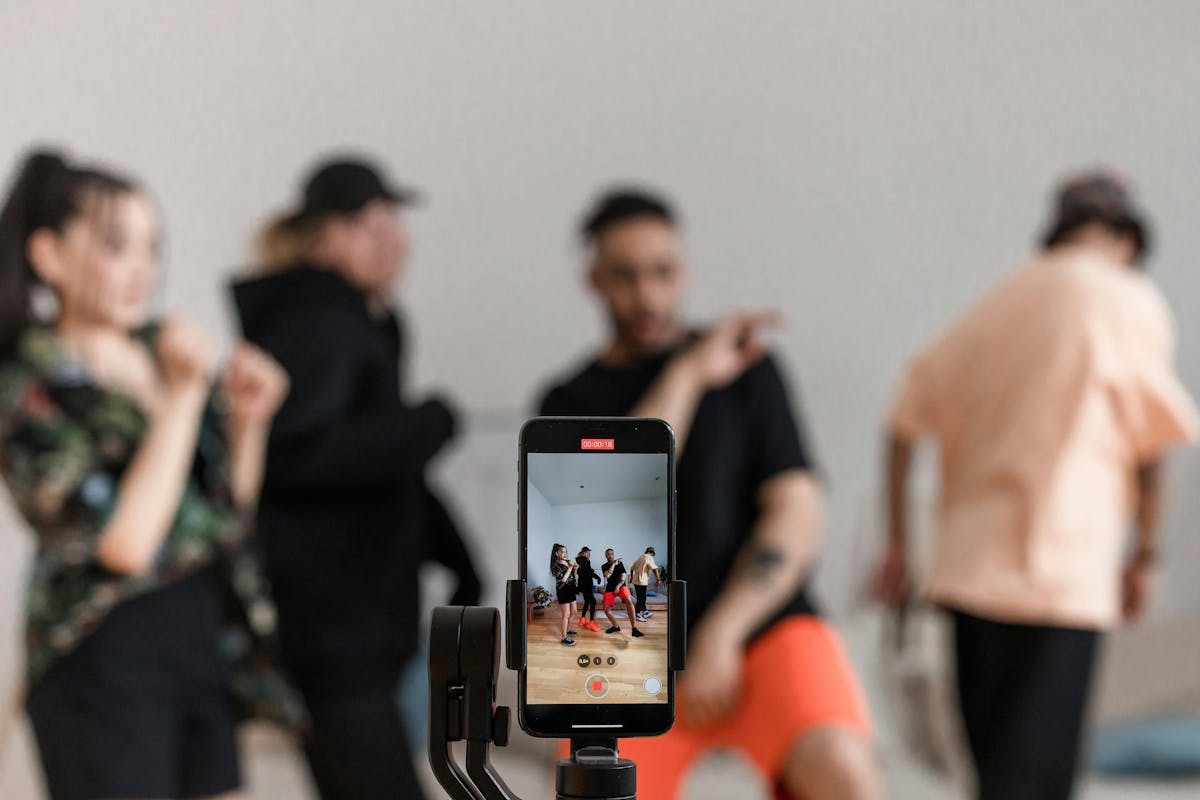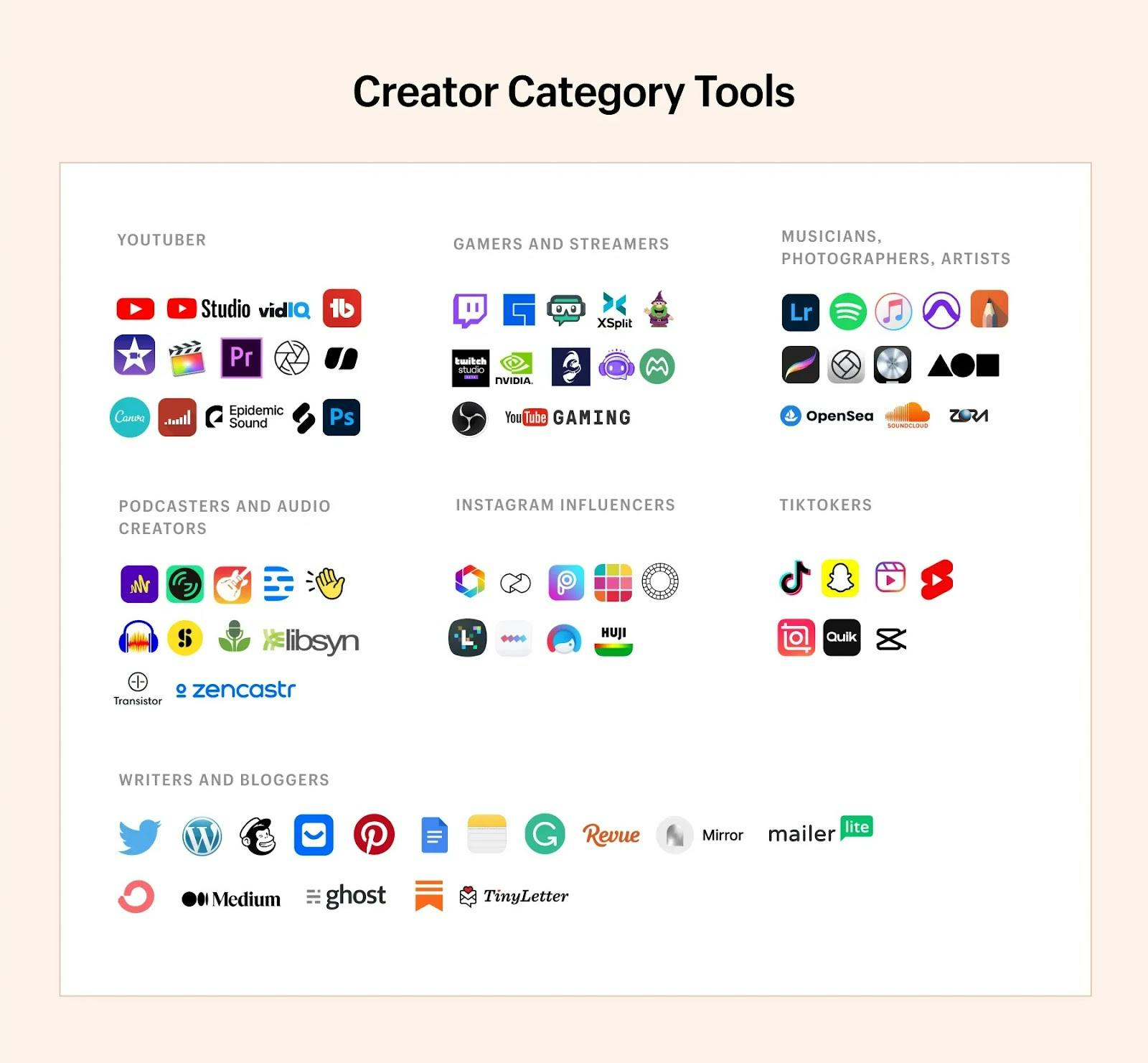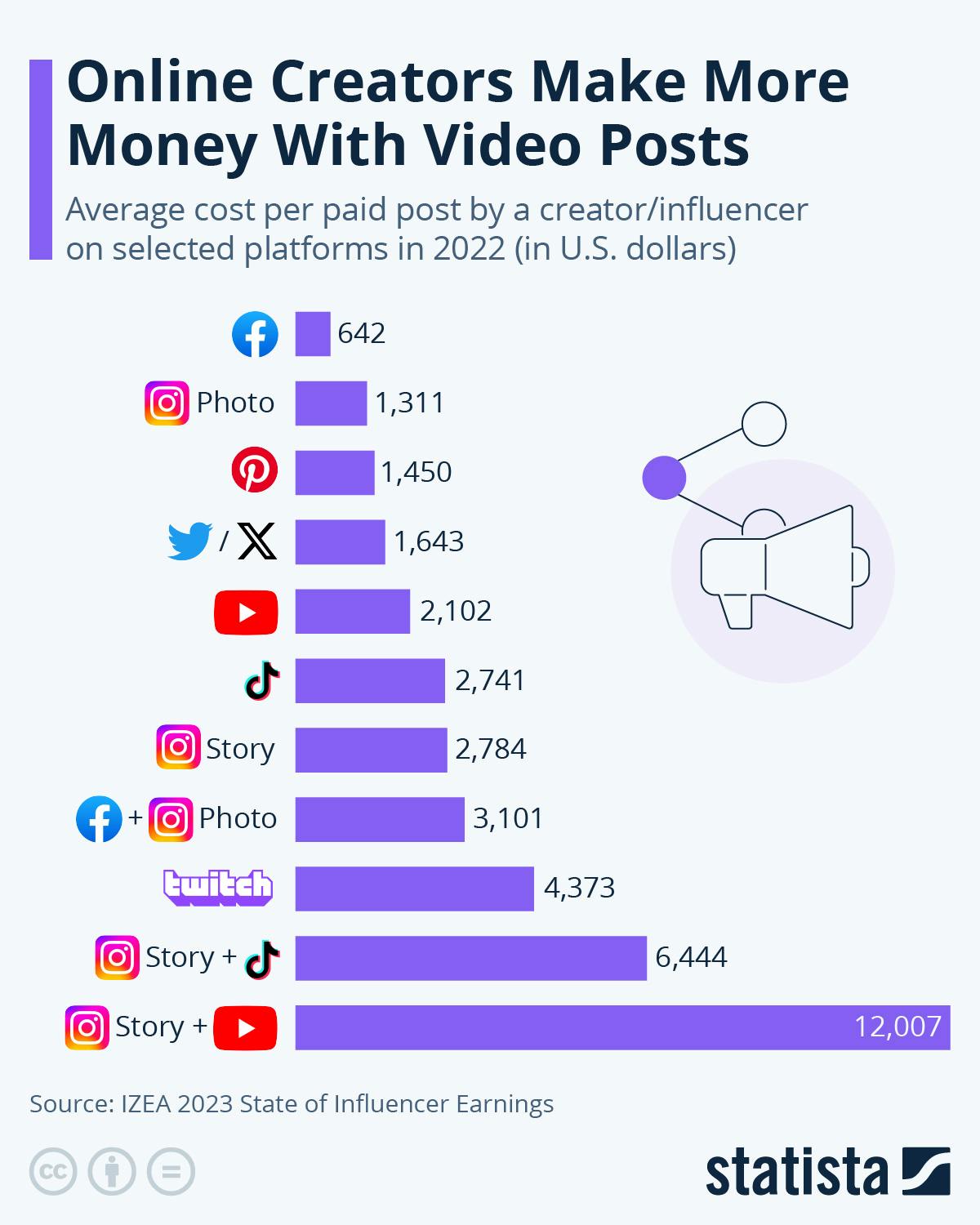What’s a Digital Creator and How Do You Become One?
Feb 6th, 2024

Contents
What is a digital creator?
How to become a digital creator?
Examples of amazing digital creators
How digital creators make money?
Digital creators play a significant role in the modern media landscape, as they can reach global audiences with their content. The rise of online platforms and social media has simplified content creation, allowing individuals with varying backgrounds and interests to become digital creators. As a result, they produce an incredible amount of content that caters to niche audiences with specific interests, whether it's fashion, gaming, travel, cooking, or any other topic.
An increasing number of businesses are turning to digital creators to enhance brand visibility and audience engagement. In this article, we will consider the concept of a digital creator, share examples, and discuss how digital creators can make money.
What is a digital creator?
A digital creator is a person who produces and distributes content on various digital platforms. The content can include images, videos, blog articles, or any other form of media. Digital creators share content on their websites and social media such as Facebook, YouTube, Instagram, Substack, or podcasts. They often build communities and followers around their content, and some may monetize their efforts through advertising, sponsorships, or selling products or services.
One of the defining characteristics of digital creators is their direct and two-way communication with their audience. Unlike traditional media, where content is broadcast to a passive audience, digital creators engage with their viewers, readers, or listeners through comments, social media interactions, and live streams. This allows for real-time feedback, collaboration, and a more profound sense of community.
The emergence of digital creators as a profession in the last fifteen years can be attributed to several key factors. First, the widespread accessibility of high-speed internet has made it easier to distribute digital content to a global audience. Second, the popularity of YouTube, Instagram, TikTok, and podcast hosting services has enabled content creators to share their work and create communities.
In addition, the development of various monetization models has made it more financially viable for individuals to pursue content creation as a full-time profession. Furthermore, as traditional media outlets faced challenges in the digital age, creators filled content gaps and catered to niche audiences.
The influencer marketing industry has also played a massive role in elevating digital creators' status, with brands recognizing the value of their authentic and engaging content. Advancements in digital tools and equipment have made creating high-quality content easier and more affordable, lowering entry barriers for aspiring creators.
How to become a digital creator?
Becoming a full-time digital creator takes lots of time and effort. This journey is full of challenges, requiring creativity, persistence, and adaptability. A digital creator’s career demands continuous learning, mastering various tools and platforms, and staying attuned to audience preferences. Nevertheless, this is a feasible goal. Now, let's examine the fundamental steps to start your adventure in digital content creation.
Step 1. Identify your niche
The first step toward a successful digital creator’s career is to find a niche you are enthusiastic about. Ask yourself which topics you specialize in and what your primary focus should be. It would be difficult to attract a devoted audience if your content is too wide-ranging, as your followers may not understand what to expect from you. Moreover, a specific niche helps maintain your consistency. In times of creative stagnation, returning to your niche can remind you of the initial purpose of content creation.
Consider the following aspects when determining your niche. Identify a topic you are passionate about or one you can quickly gain expertise in. Evaluate which niche aligns best with your interests and offers substantial revenue opportunities. Analyze current trends and audience demands to determine what content is currently popular. By examining your expertise, interests, and audience preferences, you will understand which niche market suits you the most.

While finding the right niche is essential, diving into a more specialized sub-niche can yield even greater benefits. For example, within the broad field of food content, focusing on ‘healthy meal prepping for busy professionals’ or ‘authentic Italian pasta recipes’ can give you a distinct competitive advantage. As your online presence grows, you can subsequently explore new horizons.
Step 2. Acquire the necessary skills
Acquiring the necessary skills is foundational to becoming a proficient digital creator. Depending on your chosen medium, this could involve learning graphic design, illustration, video editing, coding, writing, or a combination of these. Numerous online platforms offer courses and tutorials tailored to different skill levels. For instance, aspiring video creators might delve into video editing software like Adobe Premiere Pro or Final Cut Pro. At the same time, graphic designers could master tools such as Adobe Photoshop or Adobe InDesign.
Consistent practice and hands-on experience are crucial. Creating sample projects or participating in online communities can provide valuable feedback and support as you refine your skills. Furthermore, you should adopt a mindset of lifelong learning to stay relevant in your respective field. As technology advances and new trends emerge, staying informed becomes paramount. It involves not only mastering current tools but also being open to exploring and adopting new ones.
In addition, digital creators often benefit from having a diverse skill set that extends beyond their primary focus. For instance, understanding the basics of digital branding can be instrumental in promoting your content. Social media proficiency is vital for reaching and engaging with a broader audience. Basic knowledge of search engine optimization can help make your content more discoverable.
Step 3. Build a portfolio
Create a portfolio showcasing your best work. The portfolio serves as a digital resume and gives prospective employers or partners an idea of your experience and qualifications. Organize your portfolio in a user-friendly manner, making it easy for visitors to navigate and understand the scope of your creative talents. Include a bio or a personal statement that summarizes your background, interests, or the unique perspective you bring to your creative projects.

Beyond a standalone portfolio, establishing a professional online presence is essential. Create and optimize profiles on relevant social media platforms, using consistent branding elements to reinforce your identity as a digital creator. Actively share your work, engage with your audience, and leverage each platform's features to showcase your creativity. Consider creating a personal website to showcase your portfolio, share your story, and provide contact information for business inquiries.
Once you have established your online presence and portfolio, ask your mentors, colleagues, and audience for feedback. Be open to iterating on your portfolio based on their responses. As you receive positive feedback, consider incorporating client testimonials or endorsements into your portfolio to build trust with potential collaborators.
Step 4. Choose your platforms and gather equipment
Identify the platforms where your target audience is most active. To produce content that resonates with your target audience, it’s critical to understand your followers’ demographics, needs, and features of different platforms. For example, if you take photos or create illustrations, platforms such as Instagram, Pinterest, or ArtStation may work better for you, while YouTube and TikTok are great options for video content creators.

Gather the necessary equipment, including a microphone, camera, and lighting. If you're just starting on YouTube, your phone's camera might be enough for now. When it comes to lighting, natural sunlight streaming in from a nearby window can be a cost-effective solution. If you are looking for a microphone, Amazon offers a wide selection of affordable models, some starting at as little as $10.
Using more affordable tools to begin your creative journey is very practical. Spending thousands of dollars on expensive equipment might not be a good idea, particularly if you're just starting your career. You can experiment without making a significant financial commitment by utilizing low-cost gadgets.
Step 5. Regularly produce content
Now, it is time to dive into the creative process. In the early stages, feeling a bit uncomfortable or uncertain is normal. However, once you find a rhythm and a type of content that resonates with your audience, you will start seeing results. Establishing a schedule for digital content creation, whether it involves recording videos or brainstorming ideas, can provide structure and enhance productivity. Besides videos, try various content formats, such as podcasts and social media posts, to engage with your audience through multiple channels.
Remember that practice makes perfect, so don't let the need for perfection get in the way of your initial attempts. Keep a journal of your creative process, recording the successes and failures. Whether you write a blog, host a podcast, or publish videos on YouTube, routinely evaluate your work to improve and refine your skills.
To become a successful digital creator, you should embrace your faults. Instead of sharing polished content, telling about vulnerabilities and behind-the-scenes aspects of your creative process may help build your unique brand and trust with your audience. It's critical to strike a balance between SEO and writing for humans to prevent keyword stuffing. Finally, resist the temptation to chase every trend. Instead, focus on creating evergreen content for sustained growth. If your content does not perform well, you can repurpose it and publish it later on a different platform.
Step 6. Engage with your audience
To establish meaningful relationships with your audience, you should not only create content but also respond to comments and messages. Take the time to understand your followers' preferences and analyze questions and feedback. Utilize polls, Q&A sessions, or live streams to directly involve your audience in your creative process. By fostering a two-way dialogue, you strengthen your connection with your audience and gain valuable insights that can inform your future content.
Use analytics tools to understand which content performs well and why. By examining metrics such as views, likes, and shares, you can identify patterns and trends that will help retain your existing followers and attract new ones. Experiment with new formats, styles, or topics based on audience feedback and changing trends.
Take part in discussions within your niche and collaborate with other digital content creators to expand your reach and introduce your brand to new audiences. Cross-promoting your content on multiple platforms is a smart way to increase visibility and grow your online presence.
Step 7. Monetize your content
Many platforms offer paid opportunities for creative professionals who have reached a certain number of subscribers. The other ways to earn income as a digital creator include brand partnerships, sponsorships, and collaborations. We will discuss different methods to earn income as a digital creator further in this article.

Create a press kit to introduce yourself to brands for collaboration. Include details about your niche, the type of content you create, and the unique aspects that set you apart. Provide transparent statistics on the number of followers, emphasizing the size and engagement of your audience. This information demonstrates your reach and highlights the potential exposure a brand could gain by partnering with you.
Describe your audience’s demographics and how they align with the brand's target market. Highlight successful past collaborations or campaigns that showcase your ability to authentically integrate a brand's message into your content. Ensure that sponsored content aligns with your values and resonates with your audience to maintain trust. Be open and honest with your audience by announcing your affiliate relationships.
Step 8. Stay informed and adapt
Staying informed is crucial in the dynamic world of digital content creation. With the fast development of technology, trends, and algorithms, continuous learning is essential. To stay up to date with recent advancements, creative professionals should actively monitor resources like industry articles, forums, and relevant publications.
Whether it's adjusting content strategies based on algorithm changes or embracing new platforms to reach a broader audience, the ability to adapt is crucial for longevity in the digital space. The most resilient creators understand that strategies that worked yesterday may not be as effective tomorrow. A flexible mindset allows creative professionals to experiment with new formats, pivot when needed, and continuously produce content that resonates with their audience. Use built-in analytical tools, such as YouTube Analytics or Facebook Professional Dashboard, to see what works best for your audience.
Furthermore, digital creators should not only stay informed about the latest developments but also predict what the next big thing will be. Early adoption can help them stand out, whether utilizing new content formats, discovering virtual reality, or experimenting with innovative technologies.
Remember, success in a digital creator’s career often involves a combination of talent, hard work, and perseverance.
Examples of amazing digital creators
Now that we’ve gone through the how-to, let us consider some examples. Here are five digital creators who have achieved success in the last three years and are at the peak of their popularity.
YouTuber MrBeast
MrBeast is a YouTube sensation known for his philanthropic stunts, attention-grabbing challenges, and high-quality production. His content often revolves around massive giveaways, daring challenges, and creative charity initiatives.
His ability to capture and retain viewer attention through innovative ideas has led to incredible growth in his subscriber base. What sets him apart is not just the entertaining content but also his genuine commitment to making a positive impact on the world through his charitable endeavors.
TikTok creator Charli D'Amelio
Charli D'Amelio gained popularity on TikTok through her captivating dance videos. She has become one of the most followed and recognizable figures on the platform.
Charli's success is attributed not only to her dancing talent but also to her relatability and sincerity. By giving her audience a peek into her everyday life, she connects with them and becomes a prominent personality in the video industry. Such rapid growth in popularity demonstrates how short-form video platforms may influence digital careers.
Podcaster Joe Rogan
Joe Rogan's podcast, The Joe Rogan Experience, has become a cultural phenomenon. Rogan's laid-back interviewing style and interesting guests have contributed to the show's massive success.
The podcast covers a wide range of topics, from science and technology to comedy and politics. Rogan's authenticity and ability to engage with guests on a personal level have made his podcast one of the most listened to and influential in the world.
Substack writers
Thanks to Substack's growth, authors may now communicate directly with their readers. Several authors in various fields have succeeded with this platform by delivering exclusive content.
Substack allows writers to monetize their newsletters, providing an alternative to traditional publishing. Using Substack, creators such as Casey Newton and Anne Helen Petersen have grown devoted subscriber bases by sharing in-depth analyses, comments, and personal essays.
NFT artist Beeple
Beeple gained widespread popularity for his groundbreaking sale of digital artwork as a non-fungible token. His piece, Everydays: The First 5000 Days, was sold at a historic auction, marking a turning point in adopting digital art and NFTs. The success of Beeple highlights how the digital art industry is changing and how blockchain technology might help artists tokenize and sell their work to a global audience.
From independent writing, podcasting, and NFT painting to TikTok dancing, YouTube charity, and revolutionary art, these creators demonstrate the ever-expanding possibilities in the digital arena. Their stories highlight the crucial role of originality, creativity, and adaptability in establishing and maintaining audience engagement.
How digital creators make money?
As a digital creator, you have several options for earning money, so look for the ones suitable for your particular situation. Here are the four best ways to make money.
Sponsored posts. Featuring a brand in your publications in exchange for payment or free merchandise is an excellent way to monetize the content. This method allows digital creators to market products and services to their audience or build profitable relationships with sponsors.
Affiliate marketing. Digital creators recommend products or services from other businesses and receive a commission for each deal that results from their recommendation. By leveraging their influence and promoting products that align with their audience's tastes or niche, creators can profit from their work.
Merchandise. Creating and selling branded merchandise is a popular method for digital creators to launch their product line and monetize their brand. From clothing and accessories to customized items, merchandise allows creators to offer tangible products that resonate with their audience, creating a new revenue stream beyond digital content.
Subscriptions. Platforms like Patreon or personalized websites allow digital creators to build a paying subscriber base. By offering exclusive content to subscribers, creators can develop a dedicated community and generate consistent income through a subscription business model from their most engaged audience members.
Becoming a digital creator is a journey that requires patience, dedication, and time investment. To build a strong online presence, you must create valuable content, engage the audience, and stand out from competitors. Embrace the process, learn from experiences, and adapt your approach. Your patience today will pave the way for your success tomorrow.
